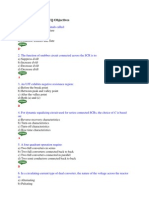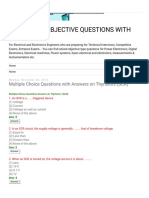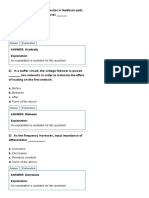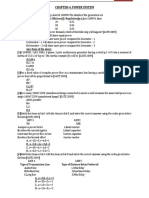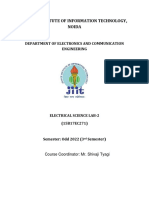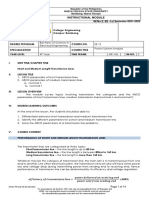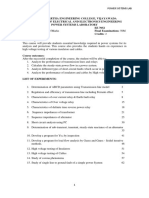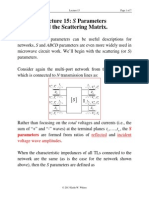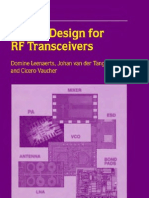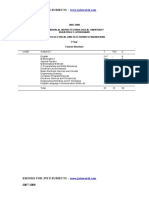Professional Documents
Culture Documents
ELECTRICAL CIRCUIT THEORY MCQs PDF
ELECTRICAL CIRCUIT THEORY MCQs PDF
Uploaded by
YashOriginal Description:
Original Title
Copyright
Available Formats
Share this document
Did you find this document useful?
Is this content inappropriate?
Report this DocumentCopyright:
Available Formats
ELECTRICAL CIRCUIT THEORY MCQs PDF
ELECTRICAL CIRCUIT THEORY MCQs PDF
Uploaded by
YashCopyright:
Available Formats
P.M.
MEVADA
CHAPTER-10. ELECTRICAL CIRCUIT THEORY
[1] The period of the signal x(t) = 8 sin (0.8πt + π /4) is [GATE 2010]
A. 0.4πs
B. 0.8πs
C. 1.25s
D. 2.5s
[2] The switch in the circuit has been closed for a long time. It is opened at t=0. At t=0+,the current through
the 1μF capacitor is [GATE 2010]
A. 0A
B. 1A
C. 1.25A
D. 5A
[3] The second harmonic component of the periodic waveform given in the figure has an amplitude of [GATE
2010]
A. 0
B. 1
C. 2/π
D. √5
[4] As shown in the figure, a 1 resistance is connected across a source that has a load line v+i=100. The
current through the resistance is [GATE 2010]
A. 25A
B. 50A
C. 100A
D. 200A
[5] If the 12Ω resistor draws a current of 1A as shown in the figure, the value of resistance R is [GATE 2010]
A. 4Ω
B. 6Ω
C. 8Ω
D. 18Ω
ELECTRICAL INTERVIEW QUESTION & ANSWER Page 97
P.M.MEVADA
[5] If the electrical circuit of figure (b) is an eqiuvalent of the coupled tank system of figure (a), then [GATE
2010]
A. A,B are resistances and C,D capacitances
B. A,C are resistances and B,D capacitances
C. A,B are capacitances and C,D resistances
D. A,C are capacitances are and B,D resistances
[7] The two-port network P shown in the figure has ports 1 and 2, denoted by terminals (a,b) and (c,d),
respectively. It has an impedence matrix Z with parameters denoted by Z ij. A 1Ω resistor is connected in series
with the network at port 1 as shown in the figure. The impedance matrix of the modified two-port network
(shown as a dashed box) is [GATE 2010]
A B C D
Ans:C
[8] The Maxwell's bridge shown in the figure is at balance.The parameters of the inductive coil are [GATE
2010]
A. R=R2R3/R4, L=C4R2R3
B. L=R2R3/R4, R=C4R2R3
C. R=R4/R2R3, L=1(C4R2R3)
D. L=R4/R2R3, R=1/(C4R2R3)
ELECTRICAL INTERVIEW QUESTION & ANSWER Page 98
P.M.MEVADA
Statement:
The L-C circuit shown in the figure has an inductance L=1mH and a capacitance C=10μF
[9]: The initial current through the inductor is zero, while the initial capacitor voltage is 100V. The switch is
closed at t=0. The current i through the circuit is: [GATE 2010]
A. 5cos(5x103t)A
B. 5sin(104t)A
C. 10cos(5x103t)A
D. 10sin(104t)A
[10]: The L-C circuit of statement is used to commutate a thyristor, which is initially carrying a current of 5A
as shown in the figure below. The values and initial conditions of L and C are the same as in statement. The
switch is closed at t=0. If the forward drop is negligible, the time taken for the device to turn off is [GATE
2010]
A. 52μs
B. 156μs
C. 312μs
D. 26μs
[11] The voltage applied to a circuit is 100√2 cos(100πt) volts and the circuit draws a current of
10√2sin(100πt +π/4) amperes. Taking the voltage as the reference phasor, the phasor representation of the
current in amperes is [GATE 2011]
A. 10√2∠- π/4
B. 10∠- π/4
C. 10∠+ π/4
D. 10√2∠+ π/4
[12] A reactance network in the Foster's I form has poles at ω=∞(infinity). The element in box-1 in the above
network is [IES2010]
ELECTRICAL INTERVIEW QUESTION & ANSWER Page 99
P.M.MEVADA
A. a capacitor
B. an inductor
C. a parallel LC circuit
D. a series LC circuit
Statement for Linked Answer Questions 12 and 13: [GATE 2009]
[12] For the circuit given above, the Thevinin's resistance across the terminals A and B is [GATE 2009]
A. 0.5kΩ
B.
C. 1kΩ
D. 0.11kΩ
[13] For the circuit given above, the Thevenin's voltage across the terminals A and B is
[GATE 2009]
A. 1.25V
B. 0.25V
C. 1V
D. 0.5V
[14] For the circuit shown, find out the current flowing through the 2Ω resistance. Also identify the changes to
be made to double the current through the 2Ω resistance. [GATE]
A. (5A;Put Vs=20V)
B. (2A;Put Vs=8V)
C. (5A;Put Vs=10A)
D. (7A;Put Vs=12A)
[15] The common emitter forward current gain of the transistor shown is 100. The transistor is operating
in [GATE 2007]
ELECTRICAL INTERVIEW QUESTION & ANSWER Page 100
P.M.MEVADA
A. Saturation Region
B. Cutoff Region
C. Reverse active region
D. Forward active region
[16] The three – terminal linear voltage regulator is connected to a 10 ohm load resistor as shown in the
figure. If Vin is 10V, what is the power dissipated in the transistor [GATE 2007]
A. 0.6W
B. 2.4W
C. 4.2W
D. 5.4W
Carry Two Marks Each Statement for Linked Answer Questions:17 & 18
In the circuit shown, the three voltmeter readings are V1=220V, V2=122V, V3=136V
[17] The power factor of the load is [GATE2012]
a. 0.45
b. 0.50
c. 0.55
d. 0.60
[18] If RL=5Ω, the approximate power consumption in the load is [GATE2012]
a. 700W
b. 750W
c. 800W
d. 850W
Common Data Questions: 19&20
With 10V dc connected at port A in the linear nonreciprocal two-port network shown below,following were
observed:
(1)1Ω connected at port B draws a current of 3A
(2) 2.5Ω connected at port B draws a current of 2A
ELECTRICAL INTERVIEW QUESTION & ANSWER Page 101
P.M.MEVADA
[19] For the same network, with 6V dc connected at port A, 1Ω connected at port B draws 7/3 A. If 8V dc is
connected to port A, the open circuit voltage at port B is [GATE2012]
a. 6V
b. 7V
c. 8V
d. 9V
[20] With 10V dc connected at port A, the current drawn 7Ω connected at port B is [GATE2012]
a. 3/7A
b. 5/7A
c. 1A
d. 9/7A
[21] A balanced RYB-sequence,Y-connected(Star Connected) source with VRN=100 volts is connected to a Δ-
connected (Delta connected) balanced load of (8+j6) ohms per phase.Then the phase current and line current
values respectively,are[IES2010]
A.10A;30A
B.10√3A;30A
C.10A;10A
D.10√3A;10√3A
[22] Assuming both the voltage sources are in phase, the value of R for which maximum power is transferred
from circuit A to circuit B is [GATE2012]
a. 0.8Ω
b. 1.4Ω
c. 2Ω
d. 2.8Ω
[23] The voltage gain Av of the circuit shown below is [GATE2012]
a. |Av| ≈200
b. |Av|≈100
c. |Av|≈20
d. |Av|≈10
ELECTRICAL INTERVIEW QUESTION & ANSWER Page 102
P.M.MEVADA
[24] If VA-VB=6V, then VC-VD is [GATE2012]
a. -5V
b. 2V
c. 3V
d. 6V
Solution Hint:
As Va-Vb =6 => I = V/R = 6/2 = 3A
entering current = leaving current [ KCL]
so current from Vd to Vc is same as 3A
convert the current source to voltage source
V = IR =2 x 1 = 2V
Vd = Vc + 2V + (3x1)V = Vc + 5V
Vc-Vd = -5V
[25]The circuit shown is a [GATE2012]
a. Low pass filter with f3db=[1/(R1+R2)C] rad/s
b.High pass filter with f3db=[1/(R1C)] rad/s
c. Low pass filter with f3db=[1/(R1C)] rad/s
d. High pass filter with f3db=[1/(R1+R2)C] rad/s
[6] In the circuit shown, an ideal switch S operated at 100kHz with a duty ratio or 50%. Given thatΔic 1.6A
peak-to-peak and I0 is 5A dc, the peak current in S is [GATE2012]
ELECTRICAL INTERVIEW QUESTION & ANSWER Page 103
P.M.MEVADA
a. 6.6A
b. 5.0A
c. 5.8A
d. 4.2A
Solution Hint:
Δic = 1.6A peak-to-peak
The positive peak = Δic /2
The current flows through the switch has a peak of = Io + Δic /2
For your information...The current waveform is like this
The lowest point will be 5A....highest point will be 5+ 0.8
[27] The i-v characteristics of the diode in the circuit given below are
i={ [ V- 0.7 /500]A, V > or = 0.7 V
0A, V< 0.7 V
The current in the circuit is [GATE 2012]
a. 10 mA
b. 9.3 mA
c. 6.67 mA
d. 6.2 mA
Sol. Hint:
we have to find v and then apply in ct. equ...
KVL...10 = 1K * i + v
10 = 1000i +v = 1000(v-0.7/500) + v
solve it ....v= 0.8...
[8] In the following figure, C1 and C2 are ideal capacitors. C1 has been charged to 12V before the ideal switch S
is closed at t=0. The current i(t) for all t is [GATE 2012]
ELECTRICAL INTERVIEW QUESTION & ANSWER Page 104
P.M.MEVADA
a. Zero
b. A step function
c. An exponentially decaying function
d. An impulse function
Sol. Hint:
If it is RC ckt...ie any Resistance in series with capacitor, it will be an exponentially decaying function....here no
resistance...so charge instantly....ie impulse function...
[9] The impedance looking into nodes 1 and 2 in the given circuit is [GATE 2012]
a. 50 Ω
b. 100 Ω
c. 5 KΩ
d. 10.1 KΩ
Ans:A
Answer
[10] In the circuit given below,the current through the inductor is [GATE 2012]
a. (2/1+j)A
b. (-1/1+j)A
c. (1/1+j)A
d. 0A
Sol Hint: consider top half of the circuit
R & L are in parallel with ct. source....other end connected to low potential...ie GND... convert ct. to V source...:
ELECTRICAL INTERVIEW QUESTION & ANSWER Page 105
You might also like
- ch19 Two-Port Networks PDFDocument19 pagesch19 Two-Port Networks PDFRohit Gandhi0% (1)
- Basic Circuit Theory, Charles A. Desoer, Ernest S. Kuh 1969 PDFDocument887 pagesBasic Circuit Theory, Charles A. Desoer, Ernest S. Kuh 1969 PDFMithun P S80% (10)
- Network Synthesis Model ExitDocument10 pagesNetwork Synthesis Model ExitERMIAS AmanuelNo ratings yet
- GATE EE 2002 Actual Paper PDFDocument24 pagesGATE EE 2002 Actual Paper PDFKeilla Romabiles LeopandoNo ratings yet
- Electronics I MCQDocument27 pagesElectronics I MCQsubhanisiriNo ratings yet
- Important Mcq-Basic Electrical Part ThreeDocument8 pagesImportant Mcq-Basic Electrical Part ThreeSudip MondalNo ratings yet
- Power Electronics MCQ ObjectivesDocument2 pagesPower Electronics MCQ ObjectivesJignesh VyasNo ratings yet
- Control Systems Questions and Answers For ExperiencedDocument5 pagesControl Systems Questions and Answers For ExperiencedMarwan Mohamed0% (1)
- Bpe MCQDocument80 pagesBpe MCQSaquibh ShaikhNo ratings yet
- Ehv Ac & DC Transmission MCQ Unit - 1Document7 pagesEhv Ac & DC Transmission MCQ Unit - 1Rohit kannojiaNo ratings yet
- Master Merge PDFDocument190 pagesMaster Merge PDFRitNo ratings yet
- Parallel Circuits6. Questions On Power and Power FactorDocument21 pagesParallel Circuits6. Questions On Power and Power Factorkibrom atsbhaNo ratings yet
- APPLIED ELECTRONICS MCQsDocument52 pagesAPPLIED ELECTRONICS MCQsIssifu IssahNo ratings yet
- Electromagnetic Theory Objective Type Questions PDFDocument50 pagesElectromagnetic Theory Objective Type Questions PDFManojDhage100% (1)
- MCQ Thyristors (SCR) PDFDocument4 pagesMCQ Thyristors (SCR) PDFpratik chakraborty80% (5)
- Linear Applications of Op-Amp - Electronic Engineering (MCQ) Questions & AnswersDocument4 pagesLinear Applications of Op-Amp - Electronic Engineering (MCQ) Questions & Answerslovelyosmile253100% (1)
- Multiple Choice Questions and Answers On Op-Amp (Operational Amplifier) - Electronics PostDocument6 pagesMultiple Choice Questions and Answers On Op-Amp (Operational Amplifier) - Electronics PostDurga Devi100% (1)
- Important MCQ - Signals and SystemsDocument15 pagesImportant MCQ - Signals and Systemsarijitlgsp0% (2)
- MCQs AmplifiersDocument5 pagesMCQs AmplifiersSam XingxnNo ratings yet
- Unit-I: Diode Circuits: PES's Modern College of Engineering, Department of Electronics & Telecommunication EngineeringDocument23 pagesUnit-I: Diode Circuits: PES's Modern College of Engineering, Department of Electronics & Telecommunication Engineering1514VARAD DUDHALMALNo ratings yet
- MCQ DC Machines MasterDocument16 pagesMCQ DC Machines MasterDeepak Choudhary DCNo ratings yet
- Multiple Choice Questions With Answers On Power Electronics and DrivesDocument3 pagesMultiple Choice Questions With Answers On Power Electronics and DrivesRaees AslamNo ratings yet
- Op-Amp MCQDocument13 pagesOp-Amp MCQAbhisek Gautam BTNo ratings yet
- Electronic MCQDocument15 pagesElectronic MCQSachin KumarNo ratings yet
- Microwave Introduction Objective QuestionsDocument4 pagesMicrowave Introduction Objective Questionsganesh4u_p0% (1)
- MCQ Electrical CircuitsDocument81 pagesMCQ Electrical CircuitsAnonymous sENwj8nwq50% (2)
- Ehv Ac & DC Transmission MCQ Unit - 2: Ans: (D)Document23 pagesEhv Ac & DC Transmission MCQ Unit - 2: Ans: (D)satya prakash100% (2)
- Questions & Answers On Techniques of Circuit AnalysisDocument47 pagesQuestions & Answers On Techniques of Circuit Analysiskibrom atsbha100% (2)
- Transistors McqsDocument12 pagesTransistors McqsKrishnaveni DhulipalaNo ratings yet
- Questions & Answers On Motor Control by Static Power ConvertersDocument12 pagesQuestions & Answers On Motor Control by Static Power Converterskibrom atsbha100% (2)
- MCQs Question Bank Basic Electrical Engineering AKTUDocument13 pagesMCQs Question Bank Basic Electrical Engineering AKTURaj ChauhanNo ratings yet
- MCQ ComseDocument5 pagesMCQ ComseSnehashis LenkaNo ratings yet
- MCQ-EC 302 (101 Question)Document17 pagesMCQ-EC 302 (101 Question)alokesh1982No ratings yet
- PSprotection MCQDocument35 pagesPSprotection MCQvipin devNo ratings yet
- Circuit Globe: All About Electrical and ElectronicsDocument6 pagesCircuit Globe: All About Electrical and ElectronicsArunNo ratings yet
- Thyristor MCQDocument6 pagesThyristor MCQnandhakumarme0% (3)
- 110 TOP MOST POLYPHASE INDUCTION MOTORS - Electrical Engineering Multiple Choice Questions and Answers Electrical Engineering Multiple Choice Questions PDFDocument32 pages110 TOP MOST POLYPHASE INDUCTION MOTORS - Electrical Engineering Multiple Choice Questions and Answers Electrical Engineering Multiple Choice Questions PDFeinsteinNo ratings yet
- Model Exit Exam Signal and System Part One 1Document5 pagesModel Exit Exam Signal and System Part One 1ERMIAS AmanuelNo ratings yet
- Digital Circuits MCQDocument49 pagesDigital Circuits MCQEliasNo ratings yet
- OP AmpsDocument13 pagesOP AmpsGepel OntanillasNo ratings yet
- Microwave Devices and Systems: Introduction To Microwave EngineeringDocument58 pagesMicrowave Devices and Systems: Introduction To Microwave EngineeringTolera GudisaNo ratings yet
- Pioneer Engineering Classes, Aligarh: TransformersDocument12 pagesPioneer Engineering Classes, Aligarh: TransformersOsama MasoodNo ratings yet
- LIC EEE-Multiple Choice Questions 2017Document11 pagesLIC EEE-Multiple Choice Questions 2017jagan40% (5)
- Commutator in DC MotorDocument2 pagesCommutator in DC MotorArmy Joel Mariano100% (1)
- Signal System 50 Most Important MCQ With SolutionDocument14 pagesSignal System 50 Most Important MCQ With SolutionattiqueNo ratings yet
- Embedded QuizDocument5 pagesEmbedded QuizJagan VNo ratings yet
- Analog Electronics Circuits (Semester V - EEE) : Important QuestionsDocument2 pagesAnalog Electronics Circuits (Semester V - EEE) : Important QuestionsHadush KingNo ratings yet
- Electronics Questions and Answers (Indiabix - Com)Document1 pageElectronics Questions and Answers (Indiabix - Com)vedhhNo ratings yet
- MCQ Caps - UnitDocument16 pagesMCQ Caps - UnitJAYANT BORDENo ratings yet
- Electrical - Apgenco 2012 Paper & KeyDocument4 pagesElectrical - Apgenco 2012 Paper & KeyGsn Reddy100% (1)
- Unit 4 MCQDocument3 pagesUnit 4 MCQThil Pa100% (1)
- Control System MCQDocument4 pagesControl System MCQPriyankNo ratings yet
- Logic Families MCQs SimpleDocument8 pagesLogic Families MCQs SimplebijukumargNo ratings yet
- Multiple Choice Questions On Single Phase Induction MotorDocument26 pagesMultiple Choice Questions On Single Phase Induction Motorbalaji1986No ratings yet
- 30 TOP MOST MAGNETIC CIRCUIT - Electrical Engineering Multiple Choice Questions and Answers Electrical Engineering Multiple Choice QuestionsDocument5 pages30 TOP MOST MAGNETIC CIRCUIT - Electrical Engineering Multiple Choice Questions and Answers Electrical Engineering Multiple Choice QuestionsVikas RazdanNo ratings yet
- Multiple Choice QuestionsDocument39 pagesMultiple Choice QuestionsHary KrizNo ratings yet
- Ipq&f U5Document6 pagesIpq&f U5Rohit kannojia50% (2)
- Earthing or Grounding MCQ Questions & Answers - Electrical EngineeringDocument4 pagesEarthing or Grounding MCQ Questions & Answers - Electrical EngineeringKhushal shendeNo ratings yet
- Objective Type Question and AnsDocument13 pagesObjective Type Question and AnsAl FathahNo ratings yet
- Power System Mcqs PDFDocument5 pagesPower System Mcqs PDFHarith NawfelNo ratings yet
- Os PB1 Ee QuestionnaireDocument16 pagesOs PB1 Ee Questionnairejohnmichaelpilota51No ratings yet
- Section-A: Question Carries One Mark. The Symbols and Denoted Letters Have Their Usual Meanings 30 X 1 30Document16 pagesSection-A: Question Carries One Mark. The Symbols and Denoted Letters Have Their Usual Meanings 30 X 1 30Srikanth AllamsettyNo ratings yet
- Es-2 Lab - ManualDocument60 pagesEs-2 Lab - Manualsatyam guptaNo ratings yet
- Instructional Module: Republic of The Philippines Nueva Vizcaya State University Bambang, Nueva VizcayaDocument14 pagesInstructional Module: Republic of The Philippines Nueva Vizcaya State University Bambang, Nueva VizcayaMae MakelbaNo ratings yet
- De-Embedding and Embedding S-Parameter Networks Using A Vector Network AnalyzerDocument24 pagesDe-Embedding and Embedding S-Parameter Networks Using A Vector Network AnalyzermagicecstaticNo ratings yet
- PS Lab Maual 7052 - MasterDocument70 pagesPS Lab Maual 7052 - MasterSunilNo ratings yet
- Network HandoutDocument151 pagesNetwork HandoutLeti TadesseNo ratings yet
- A Tuning Method For Microwave Filter Via Complex Neural Network and Improved Space MappingDocument7 pagesA Tuning Method For Microwave Filter Via Complex Neural Network and Improved Space MappingAlgerian AissaouiNo ratings yet
- EC8251-Circuit Analysis PDFDocument30 pagesEC8251-Circuit Analysis PDFPalanikumar Pitchaikani0% (1)
- Sample 6181Document11 pagesSample 6181Hxhanannx0% (1)
- Lecture 15: S Parameters and The Scattering MatrixDocument7 pagesLecture 15: S Parameters and The Scattering MatrixDinda NurhayatiNo ratings yet
- Design and Characterization of A 6 18 GHZ Gan On Sic High Power Amplifier Mmic For Electronic WarfareDocument10 pagesDesign and Characterization of A 6 18 GHZ Gan On Sic High Power Amplifier Mmic For Electronic WarfareRAJA RAMALINGAMNo ratings yet
- Two-Port Networks (Students Copy)Document19 pagesTwo-Port Networks (Students Copy)badreeborhanNo ratings yet
- Yanosh - Irani - Final PHD ThesisDocument217 pagesYanosh - Irani - Final PHD ThesisSadeeskumar NilNo ratings yet
- Institute of Aeronautical Engineering: (Autonomous)Document4 pagesInstitute of Aeronautical Engineering: (Autonomous)VigneshNo ratings yet
- 101 2018 0 BDocument32 pages101 2018 0 BRixizoNgobeniNo ratings yet
- IEEE Format FRA Draft Guide D6Document40 pagesIEEE Format FRA Draft Guide D6Diego BetancourtNo ratings yet
- S Parameter BasicsDocument20 pagesS Parameter BasicsMihailNo ratings yet
- NAS QuizDocument11 pagesNAS QuizsubodhNo ratings yet
- (Download PDF) Circuit Theory and Networks Analysis and Synthesis 2Nd Edition Ravish R Singh Online Ebook All Chapter PDFDocument29 pages(Download PDF) Circuit Theory and Networks Analysis and Synthesis 2Nd Edition Ravish R Singh Online Ebook All Chapter PDFdonnie.bunning953100% (14)
- Hybrid Microstrip Diplexer Design For Multi-Band WDocument9 pagesHybrid Microstrip Diplexer Design For Multi-Band WyyryNo ratings yet
- Circuit Design For RF Transceivers (Book)Document350 pagesCircuit Design For RF Transceivers (Book)rrdirin90% (10)
- Instant Download Ebook PDF Electronics and Circuit Analysis Using Matlab 2nd Edition PDF ScribdDocument41 pagesInstant Download Ebook PDF Electronics and Circuit Analysis Using Matlab 2nd Edition PDF Scribdsean.cunningham518100% (51)
- Lect 8 Amplifier DesignDocument21 pagesLect 8 Amplifier DesignCyrille MagdiNo ratings yet
- Multistage Amplifier (CASCADE)Document58 pagesMultistage Amplifier (CASCADE)Junile Denampo100% (1)
- Microwave NetworksDocument66 pagesMicrowave NetworksSanu RoyNo ratings yet
- Na Question BankDocument13 pagesNa Question BankkrishmkeeeNo ratings yet
- Power Transfer Capability - BasuDocument2 pagesPower Transfer Capability - BasusoyteleNo ratings yet
- Ebooks For Jntu Subjects: 2007-2008Document102 pagesEbooks For Jntu Subjects: 2007-2008Srinivas RaoNo ratings yet
- Fet Amplifiers-ReviewDocument9 pagesFet Amplifiers-ReviewjjeongdongieeNo ratings yet






